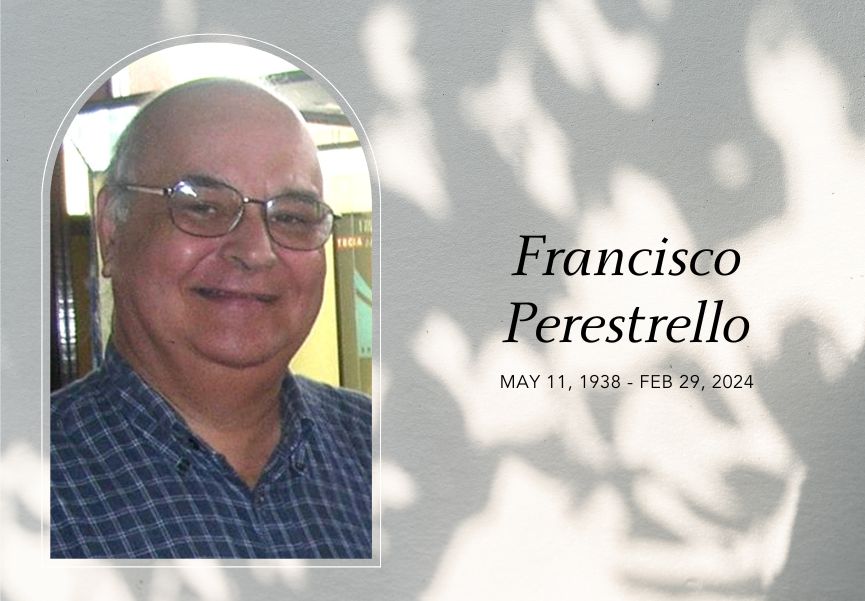Francisco Perestrello was born on 11th May 1938 in Lisbon. The younger brother of 7, he graduated as a Mechanic Engineer and married Luísa Ales do Rio, having 4 children. Francisco was one of the most compelling writers and inspiring forces of Boletim Cinematográfico (BC). Created CINEDOC and was the active representative of OCIC and SIGNIS in Portugal until 2010. He was a most respected and accepted Catholic journalist in the film world in Portugal, closely related to the media, producers, distributors, TV channels, video editors, and official film entities. Known for his sense of ethics, open mind, kindness, and entrepreneurshipness, Francisco died at 85 years old in Lisbon on the 26th of February 2024.
Francisco Perestrello was one of the notable figures of the OCIC (International Catholic Organization for Cinema) and later of SIGNIS (World Catholic Association for Communication), particularly in its European section. Together with his wife, Luísa, he left an indelible mark on the international film scene from the late 1960s to the first decade of the 21st century, almost half a century.
In the sixties, Portugal had a long tradition of affiliation with OCIC and Unda (International Catholic Association for Radio and Television), carrying out Catholic Action in radio and cinema since 1937, the year of the publication of the encyclical Vigilanti Cura.
With Francisco’s involvement, the Portuguese Catholic Action in cinema, and its publication, the Boletim Cinematografico – the smallest but most appreciated cinema magazine in the Portuguese-speaking world – once again became an integral part of OCIC, especially in Europe. During the dictatorship of Salazar, he was also active in the world of cine-clubs which was a place of resistance against censorship and Fascism. He was a highly defender of Democracy and free speech. In the 1960s Catholic Action members became active against the regime and the Catholic Radio Renascença gave the signal on April 24 1974 to start the attack against the dictatorship. Francisco had also been a film advisor for the Portuguese Catholic Bishops Conference.
Always accompanied by Luísa, they participated in numerous OCIC world congresses between 1967 and 2009, and even in a discreet way he was standing out at OCIC-Europe meetings. Francisco gained widespread respect as a member of international Catholic juries (OCIC juries) at the most prestigious international festivals, often exerting significant influence on the selection of winners. Proficient in Portuguese, English, French, and Spanish, he possessed a broad general culture and a deep knowledge of cinema in particular, demonstrating remarkable empathy and sensitivity towards the seventh art, despite always emphasizing his academic background as an engineer with a distinguished professional career at the multinational Xerox for he was the leading person in Portugal. In 1967, Francisco served on a jury at the San Sebastian Film Festival for the first time. To the great surprise of the Portuguese and Spanish Episcopal Conferences, the cinema censors of the Portuguese dictatorship and even the festival organizers, the OCIC jury awarded its prize to ‘Jovita,’ a film by Janusz Morgenstern produced in Communist Poland. A somewhat prophetic choice and a subtle affirmation of the persistence of Christian values on the other side of the Iron Curtain, as a symbol of cultural resistance to communism. Francisco would return nine times to San Sebastian in the following two decades.
At the 1988 OCIC-Europe congress, Francisco played a key role in revitalizing the organization, which had somewhat declined in previous years. He quickly organized the first Lisbon World Educational Video Forum, held in October of that same year, with the support of the Portuguese government and the City Council. In addition, he worked on integrating an OCIC Jury into the then-emerging Festroia – International Film Festival of Troia in Setúbal. A remarkable step and bond, revealing the vision and open-mindedness of both protagonists, given that the festival’s president, Mário Ventura, was not Catholic and had no particular affinity with the Church. However, it was the recognition of the added value that OCIC represented for the festival, due to the values that the award praised, and the openness with which it reinforced the presence of quality films from countries with limited access to the commercial circuit, that convinced Ventura to open the door to the OCIC.
Francisco’s commitment had a significant impact on relations between the Church and the local non-believing community: within the festival context, he promoted annual meetings between Dom Manuel Martins, Bishop of Setúbal, and Mário Ventura, forging a friendship between them. Dom Manuel would eventually persuade Ventura to move the festival from Troia to Setúbal as an integral part of the city’s cultural policy.
Combining a passion for cinema, the growing mission of strengthening ties between the Church and the world of cinema, and professional know-how in the information and documentation technology sector, Perestrello created and directed CINEDOC – Cinematographic and audiovisual documentation center focused on four essential areas: 1. The preservation and continuous enrichment of the vast personal cinematographic documentary archive, supplemented by the Cinematographic Bulletin archive; 2. The creation and continuous updating of a pioneering database, still unique in the country, with records of all films screened in Portugal, from the earliest times; 3. Monitoring current cinematography with the writing and publication of its own criticism (cinedocfilm), providing information and creating content for multiple media and festivals; 4. The official representation of OCIC, later integrated into SIGNIS, in Portugal with a constant presence on juries of national and international festivals around the world. Francisco Perestrello symbolized the essence of Catholic Action in Cinema: cultivating active, accepted, and respected Catholic journalism in the national film community. For him, the important thing was not to promote militant or catechetical Catholic cinema, but rather the elevation of human values rooted in Christian principles.
With Festroia, OCIC, now represented by the vitality of Cinedoc, intensified collaboration with the festival and even consulted on the selection of the films for the festival, one of the most appreciated in Europe. Festroia became a precious training ground for young OCIC jurors. Thanks to the excellent relationship between both protagonists, OCIC organized the first European Meeting of Young Catholic Critics in Troia/Setubal, with more than forty participants, half of whom came from Eastern Europe. This was in the early nineties less than four years after the fall of the Wall. Fr. Ambros Eichenberger, president of OCIC, praised Francisco for orchestrating the most successful cinema meeting he had ever witnessed, emphasizing that such a feat would have been impossible without his role and the financial support of the festival. In 2014 SIGNIS celebrated 25 years of a Catholic jury at the Festroia Festival in Portugal by giving personal awards to the Festival’s Director, Fernanda Silva, and two long-time SIGNIS collaborators, Canon Antonio Rego and Francisco Perestrello.
Between 1988 and 2015, I had the privilege of Francisco’s company annually in Lisbon and Setúbal, where we spent a week together every day. Initially, our conversations focused on the crucial importance of the database he was building with the CINEDOC team, before the existence of the IMDB (International Movie Database). Francisco emphasized the careful registration and archiving of cinema publications by OCIC members, especially Europeans, in the database. But in Portugal and the Portuguese world CINEDOC became even as important, if not even more important than IMDB. It was the “only source in Portugal” with Portuguese titles of films, regardless of the format in which they were presented, and also included “data on the distribution circuit of each feature film, whether it premiered in theaters, was released on video, DVD or UMD, or aired on television on open channels or any of the cable channels.” This database included close to 100,000 films and represented “a national heritage of incalculable value.” In 2022, also through the hand and passion of Perestrello, Zoomwin appeared to do what the CINEDOC page had not been able to. At this moment, the new platform integrates a total of 114,236 titles, allowing for cross-referenced searches by films, genres, directors, actors, producers, musicians, screenwriters, editors, photographers, and distributors. One can say that the promise OCIC had made to Mario Ventura and Festroia to work on a significant database on film was kept. Francisco reviewed and made important content contributions to much of the book I wrote in 2011 about Mozambican Cinema.
In hindsight, Francisco was a discreet yet driving force in the over forty years of existence of OCIC World, OCIC-Europe, and later SIGNIS, overcoming all obstacles to ensure the presence of professional Catholic cinematographic journalism in the world of film press. A world in which official Church bodies were and are practically absent.
In many ways, Francisco leaves a timeless legacy, having been an inspiration to countless young film critics, like myself.
February 29, 2024
Written by:
Dr. Convents Historian and anthropologist
Member of the SIGNIS Cinemadesk.
Specialist in Non-Western, African contemporary and colonial and Belgian Cinema
Former director of Communication – responsible of the publications and archives- and Coordinator of the Cinema Desk of OCIC/SIGNIS.


